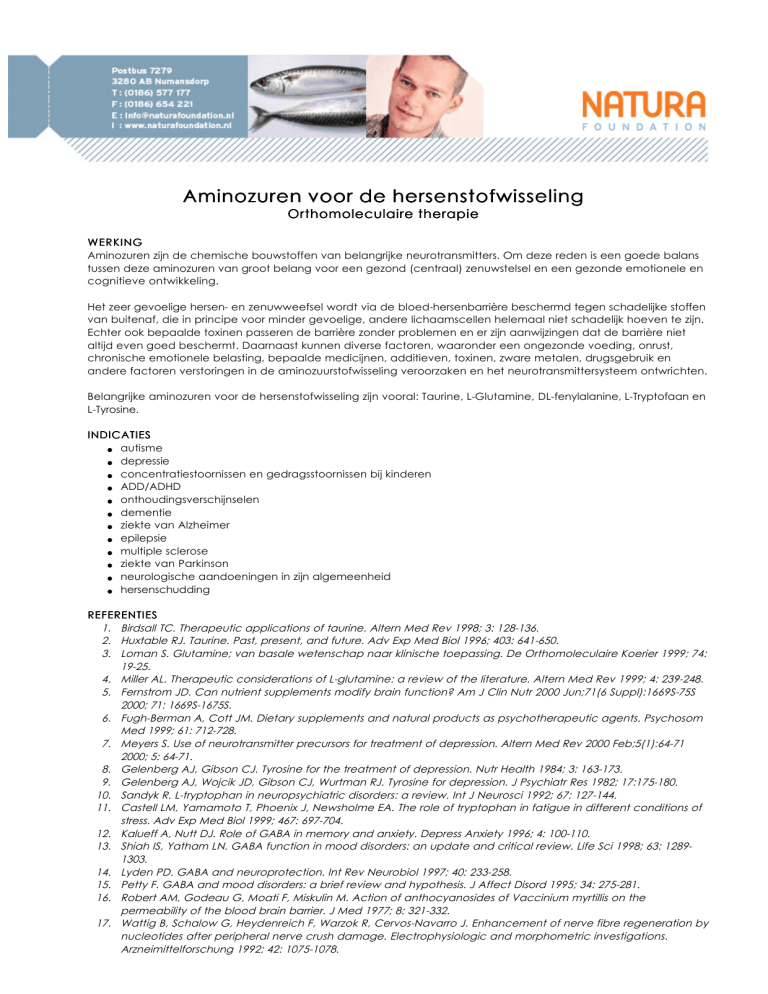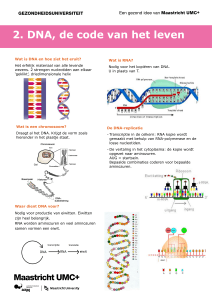
Aminozuren voor de hersenstofwisseling
Orthomoleculaire therapie
WERKING
Aminozuren zijn de chemische bouwstoffen van belangrijke neurotransmitters. Om deze reden is een goede balans
tussen deze aminozuren van groot belang voor een gezond (centraal) zenuwstelsel en een gezonde emotionele en
cognitieve ontwikkeling.
Het zeer gevoelige hersen- en zenuwweefsel wordt via de bloed-hersenbarrière beschermd tegen schadelijke stoffen
van buitenaf, die in principe voor minder gevoelige, andere lichaamscellen helemaal niet schadelijk hoeven te zijn.
Echter ook bepaalde toxinen passeren de barrière zonder problemen en er zijn aanwijzingen dat de barrière niet
altijd even goed beschermt. Daarnaast kunnen diverse factoren, waaronder een ongezonde voeding, onrust,
chronische emotionele belasting, bepaalde medicijnen, additieven, toxinen, zware metalen, drugsgebruik en
andere factoren verstoringen in de aminozuurstofwisseling veroorzaken en het neurotransmittersysteem ontwrichten.
Belangrijke aminozuren voor de hersenstofwisseling zijn vooral: Taurine, L-Glutamine, DL-fenylalanine, L-Tryptofaan en
L-Tyrosine.
INDICATIES
● autisme
● depressie
● concentratiestoornissen en gedragsstoornissen bij kinderen
● ADD/ADHD
● onthoudingsverschijnselen
● dementie
● ziekte van Alzheimer
● epilepsie
● multiple sclerose
● ziekte van Parkinson
● neurologische aandoeningen in zijn algemeenheid
● hersenschudding
REFERENTIES
1. Birdsall TC. Therapeutic applications of taurine. Altern Med Rev 1998; 3: 128-136.
2. Huxtable RJ. Taurine. Past, present, and future. Adv Exp Med Biol 1996; 403: 641-650.
3. Loman S. Glutamine; van basale wetenschap naar klinische toepassing. De Orthomoleculaire Koerier 1999; 74:
19-25.
4. Miller AL. Therapeutic considerations of L-glutamine: a review of the literature. Altern Med Rev 1999; 4: 239-248.
5. Fernstrom JD. Can nutrient supplements modify brain function? Am J Clin Nutr 2000 Jun;71(6 Suppl):1669S-75S
2000; 71: 1669S-1675S.
6. Fugh-Berman A, Cott JM. Dietary supplements and natural products as psychotherapeutic agents. Psychosom
Med 1999; 61: 712-728.
7. Meyers S. Use of neurotransmitter precursors for treatment of depression. Altern Med Rev 2000 Feb;5(1):64-71
2000; 5: 64-71.
8. Gelenberg AJ, Gibson CJ. Tyrosine for the treatment of depression. Nutr Health 1984; 3: 163-173.
9. Gelenberg AJ, Wojcik JD, Gibson CJ, Wurtman RJ. Tyrosine for depression. J Psychiatr Res 1982; 17:175-180.
10. Sandyk R. L-tryptophan in neuropsychiatric disorders: a review. Int J Neurosci 1992; 67: 127-144.
11. Castell LM, Yamamoto T, Phoenix J, Newsholme EA. The role of tryptophan in fatigue in different conditions of
stress. Adv Exp Med Biol 1999; 467: 697-704.
12. Kalueff A, Nutt DJ. Role of GABA in memory and anxiety. Depress Anxiety 1996; 4: 100-110.
13. Shiah IS, Yatham LN. GABA function in mood disorders: an update and critical review. Life Sci 1998; 63: 12891303.
14. Lyden PD. GABA and neuroprotection. Int Rev Neurobiol 1997; 40: 233-258.
15. Petty F. GABA and mood disorders: a brief review and hypothesis. J Affect Disord 1995; 34: 275-281.
16. Robert AM, Godeau G, Moati F, Miskulin M. Action of anthocyanosides of Vaccinium myrtillis on the
permeability of the blood brain barrier. J Med 1977; 8: 321-332.
17. Wattig B, Schalow G, Heydenreich F, Warzok R, Cervos-Navarro J. Enhancement of nerve fibre regeneration by
nucleotides after peripheral nerve crush damage. Electrophysiologic and morphometric investigations.
Arzneimittelforschung 1992; 42: 1075-1078.
18. Wattig B, Schalow G, Madauss M, Heydenreich F, Warzok R, Cervos-Navarro J. Acceleration of nerve and
muscle regeneration by administration of nucleotides--electroneurophysiological and morphometrical
investigations. Acta Histochem Suppl 1992; 42: 333-339.
19. Fekkes D, van der Cammen TJ, van Loon CP, et al. Abnormal amino acid metabolism in patients with early
stage Alzheimer dementia. J Neural Transm 1998; 105: 287-294.
20. Basun H, Forssell LG, Almkvist O, et al. Amino acid concentrations in cerebrospinal fluid and plasma in
Alzheimer's disease and healthy control subjects. J Neural Transm Park Dis Dement Sect 1990; 2: 295-304.
21. Croonenberghs J, Delmeire L, Verkerk R, et al. Peripheral markers of serotonergic and noradrenergic function in
post-pubertal, caucasian males with autistic disorder. Neuropsychopharmacology 2000 Mar;22(3):275-83 2000;
22: 275-283.
22. McDougle CJ, Naylor ST, Cohen DJ, Aghajanian GK, Heninger GR, Price LH. Effects of tryptophan depletion in
drug-free adults with autistic disorder. Arch Gen Psychiatry 1996; 53: 993-1000.
23. Moreno-Fuenmayor H, Borjas L, Arrieta A, Valera V, Socorro-Candanoza L. Plasma excitatory amino acids in
autism. Invest Clin 1996; 37: 113-128.
24. Irwin M, Belendiuk K, McCloskey K, Freedman DX. Tryptophan metabolism in children with attentional deficit
disorder. Am J Psychiatry 1981; 138: 1082-1085.
25. Raskin LA, Shaywitz SE, Shaywitz BA, Anderson GM, Cohen DJ. Neurochemical correlates of attention deficit
disorder. Pediatr Clin North Am 1984; 31: 387-396.
26. Kidd PM. Attention Deficit/Hyperactivity disorder (ADHD) in children: rationale for its integrative management
[In Process Citation]. Altern Med Rev 2000 Oct;5(5):402-28 2000; 5: 402-428.
27. Brod SA, Lindsey JW, Wolinsky JS. Multiple sclerosis: clinical presentation, diagnosis and treatment [published
erratum appears in Am Fam Physician 1997 Feb 1;55(2):448]. Am Fam Physician 1996; 54: 1301-6, 1309-11.
28. Katchalski-Katzir E. Synthesis, structure and function of poly-alpha-amino acids--the simplest of protein models.
Cell Mol Life Sci 1997; 53: 780-789.












